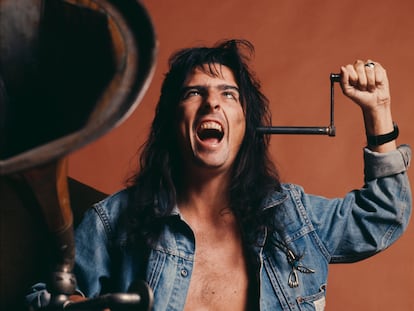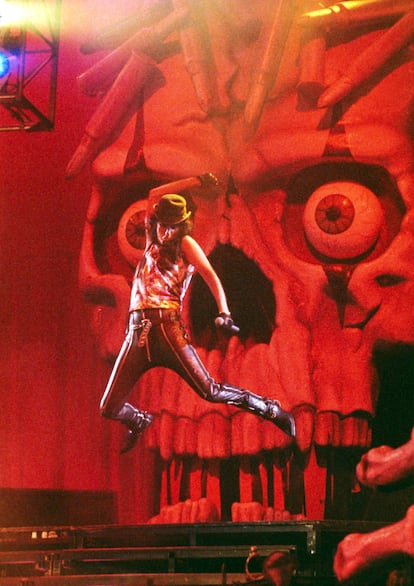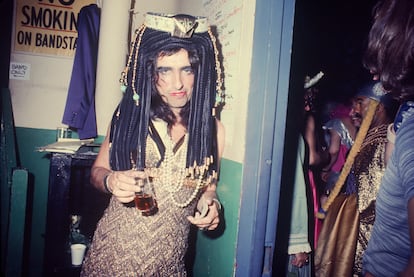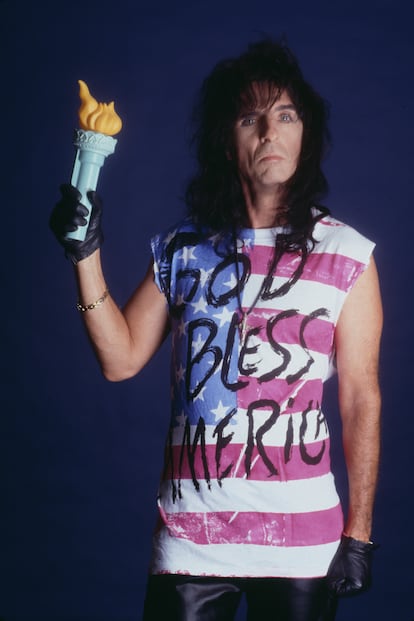‘This could be Alice Cooper’s last night’: when a rock star almost died by hanging himself live
The Detroit rocker had been perfecting his macabre stage tricks for years, using everything from trick guillotines to toy machine guns. But one night, 35 years ago, he went too far with a noose


D. Boon — lead singer for the American hardcore band Minutemen — said that dying doing what really excites you isn’t even dying. We would have to find a different word to describe it. Vincent Damon Fournier — better known as Alice Cooper — is enthusiastic about faking his own death on stage, whether he’s guillotined, electrocuted, or dismembered. The 75-year-old Detroit-born rock singer has been shot by a firing squad or dropped from a scaffold, with a noose around his neck.
The papier-mâché performances have always been part of his peculiar way of conceiving rock as an electrifying and macabre circus show; an incursion into the lion’s cage, designed to provide the public with an extra dose of adrenaline. This custom — already introduced at the dawn of his career — was taken to a new level on his 1973 tour, with a “suicidal” journey in which the musician was “executed” up to 78 times, in places such as Charlotte, Philadelphia, Vancouver, or New York.
However, a decade-and-a-half later in April of 1988 his umpteenth mock hanging nearly cost him his life, in one of the most peculiar accidents in the history of live music. The Detroiter explained what happened much later, in an interview with Entertainment Weekly. The event took place at London’s Wembley Stadium, during the general rehearsal for his European tour: Raise Your Fist and Yell. Cooper, then 40, had just returned to the states after being diagnosed with cirrhosis in 1983. Upon his return, he had recorded a couple of “gloomy” heavy metal albums, shot a live concert video, The Nightmare Returns (1987), and made a brief tour of North America. Rolling Stone noted that he had returned as a “pale reflection” of what he had been in his prime, though he was still “willing to inoculate a new generation with the virus of dislocated and demented rock.”
All he needed to do was reconnect with his audience on the other side of the pond. His European fans had contributed so much to elevating him at the dawn of the glam era, when — in the United States — he was mostly seen as a grotesque clown. Cooper was convinced that the winds of fashion were blowing in his favor in the spring of 1988. After a couple of “prosaic” years in which rock seemed to have lost “the ability to dream,” the vigorous irruption into popular culture of the slasher genre — with film sagas such as Friday the 13th or A Nightmare on Elm Street — awakened the thirst for blood and truculence in a new batch of teenagers.

Cooper wanted to run to meet that new audience. Perhaps, at that point in his career — with divorces and liver problems plaguing him — he was no longer in a position to release songs as fresh and forceful as School’s Out or No More Mr. Nice Guy, masterpieces in the theater of the absurd. But he did feel qualified to offer an “energetic, controversial and scary” live show, like in the old days. In this context, returning to his traditional false execution on a scaffold — unseen in European venues for five years — seemed like a safe bet.
The trick in question had been one of the stellar contributions to the Billion Dollar Babies tour (1973) by magician James Randi — the man Cooper describes as “the Gandalf of rock & roll.” Born in Toronto, Randi was quite a character, an illusionist who had made a living practicing “white magic” well into the 1960s, who then recycled himself as a professional skeptic, the scourge of false gurus, healers, hypnotists and psychics, whom he ridiculed in public with his exhaustive knowledge of the crude tricks that their supposed “powers” were based on.
Randi also had a remarkable capacity for escapism, in the spirit of Harry Houdini. He had perpetrated feats such as escaping a straitjacket while suspended upside down over Niagara Falls. The Amazing Randi caught the attention of the young Cooper in the early 1970s. Obsessed with giving live music an ever-increasing dose of spectacularity and “magic,” the Detroit native found a formidable ally in the escape artist.
Cooper had “hanged” himself on stage before — in a much less convincing and somewhat precarious way — but Randi taught him to perform the trick with precision worthy of the best magic shows. It consisted of the singer rising and “falling,” by using a harness attached to the ceiling beams by a thick piano rope. Thus, at the time of the execution, the rope was kept a short distance from Cooper’s neck, but without coming into contact with him.

The ritual was that, in the final stretch of the concerts, Cooper would be “judged” for his multiple outrages and outrages. The public invariably would shout: “Hang him, hang him!” And Randi’s trick gallows did the rest, providing the audience with a moment of morbid stupefaction.
As Cooper explained, at the Wembley rehearsal, the gallows were set up as usual, just as the crew had been doing since 1973. But it wasn’t taken into account that “even strong piano strings deteriorate over time.” The Gandalf of rock & roll was no longer part of the crew. Hence, Cooper performed the trick at his free will, without taking the necessary precautions.
At the climax, the harness rope gave way. And, for a moment, the rope tightened around Cooper’s neck. He could feel “with chilling clarity” how it hit his chin. Luckily, it wasn’t too tight. Cooper — in a display of reflexes — was able to escape death’s embrace in the air. “I fell to the ground and lost consciousness, but I was able to live to tell the tale.”

The only physical consequences of this near-death experience were “some annoying grazes on the neck that lasted several weeks.” Given the circumstances, the singer was careful not to bring out another of the spectacular tools inherited from Randi: the false step through the guillotine that had been all the rage on his 1975 tour. But, despite everything, he still gave his concert.
Cooper, in short, was about to join the quite extensive list of rock & roll martyrs whose recklessness or bad luck led to a premature death on stage. Les Harvey, the guitarist from the Glasgow band Stone the Crows, was electrocuted by his microphone during a concert in Swansea, Wales, in May of 1972. Pedrag Jovivic of the Yugoslav rock band San was also the victim of an electric shock that shook the stage in the city of Niš, in 1975. Country Dick Montana, the percussionist for The Beat Farmers, continued playing a show in Whistler, Canada, in 1995, despite feeling the first symptoms of the acute heart attack that would cost him his life. As for Mark Sandman — singer and bassist of the group Morphine — his heart also stopped in the middle of a concert, on July 3, 1999.
As Matt Elliott explains in Esquire, Cooper “made simulated deaths an essential part of his show.” It was the extra ingredient that elevated his live shows to another dimension. However, when a well-executed but high-risk stunt becomes routine, “all the conditions are in place for a disaster to occur.”
Cooper took the incident with good sportsmanship. “When you go to the circus and see a trainer locked in a cage with 12 tigers, there’s always the possibility that one of the tigers behaves inappropriately. Let’s say that danger is part of the show. You go into it knowing that you may be about to witness a tragedy… and that makes everything much more interesting and authentic. I’ve always wanted to integrate that point of uncertainty into my show. I want people to think: ‘This could be Alice Cooper’s last night.’”

Music critic Simon Reynolds wrote, in his wonderful book Shock and Awe: Glam Rock and its Legacy, from the 1970s to the 21st Century, that glam rock was nothing more than a visceral and youthful reaction against how “sophisticated, boring and elitist” rock & roll had become by the end of the 1960s. The subsequent generation — the “shock rock” generation — wanted to return to that source of primal energy that Elvis Presley or Chuck Berry had brought forth, while injecting it with an additional dose of theatricality, sexual ambiguity, esthetic ambition, extravagance and danger.
Cooper, in Reynolds’ opinion, doesn’t have a musical legacy on par with that of David Bowie, T.Rex, or Roxy Music. But he does rank very highly when it comes to extravagance and daring. For the British critic, the 20-year-old Vincent Damon Fournier (Alice Cooper) wanted to share with the world his adolescent enthusiasm for loud, energetic music, horror and science fiction films, gothic novels, television and delirium. Armed with an arsenal of fantasy references, he formed a band, created a subgenre (shock rock) and offered some of the most delirious and fun concerts of the early 1970s, He captured the adolescent fantasies of a new generation of music lovers.
According to Reynolds, after this intense period in Cooper’s career, he became “civilized and sweetened” and would eventually aspire to become “a respectable citizen.” But he never made concessions on his feverish and radical sense of spectacle. Hence, even in the transition to maturity, with a battered liver and a broken heart, he was willing to get into the tiger cage, despite the risk of receiving a fatal blow. That commitment to the theatricality of his live performances is perhaps the most memorable and attractive part of his legacy. His rock & roll was one that came with a noose around its neck.
Sign up for our weekly newsletter to get more English-language news coverage from EL PAÍS USA Edition
Tu suscripción se está usando en otro dispositivo
¿Quieres añadir otro usuario a tu suscripción?
Si continúas leyendo en este dispositivo, no se podrá leer en el otro.
FlechaTu suscripción se está usando en otro dispositivo y solo puedes acceder a EL PAÍS desde un dispositivo a la vez.
Si quieres compartir tu cuenta, cambia tu suscripción a la modalidad Premium, así podrás añadir otro usuario. Cada uno accederá con su propia cuenta de email, lo que os permitirá personalizar vuestra experiencia en EL PAÍS.
¿Tienes una suscripción de empresa? Accede aquí para contratar más cuentas.
En el caso de no saber quién está usando tu cuenta, te recomendamos cambiar tu contraseña aquí.
Si decides continuar compartiendo tu cuenta, este mensaje se mostrará en tu dispositivo y en el de la otra persona que está usando tu cuenta de forma indefinida, afectando a tu experiencia de lectura. Puedes consultar aquí los términos y condiciones de la suscripción digital.
Archived In
Últimas noticias
Most viewed
- Sinaloa Cartel war is taking its toll on Los Chapitos
- Oona Chaplin: ‘I told James Cameron that I was living in a treehouse and starting a permaculture project with a friend’
- Reinhard Genzel, Nobel laureate in physics: ‘One-minute videos will never give you the truth’
- Why the price of coffee has skyrocketed: from Brazilian plantations to specialty coffee houses
- Silver prices are going crazy: This is what’s fueling the rally








































